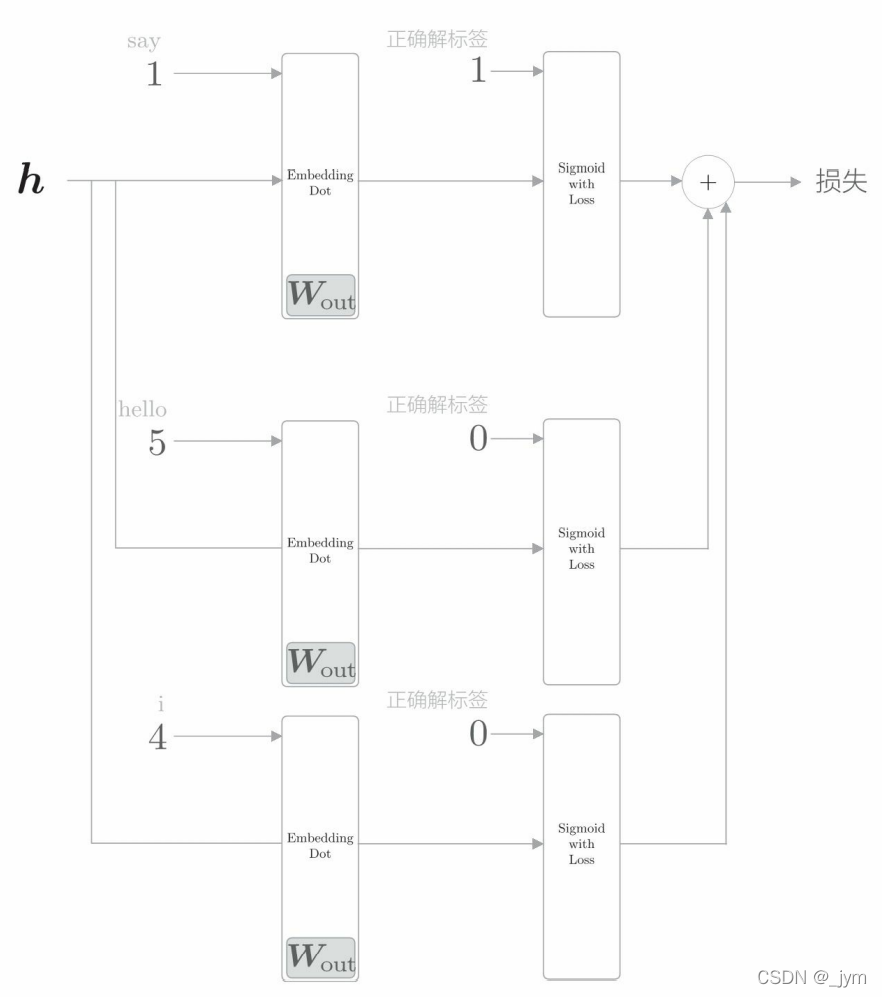nlp 二分类 改进CBOW
2022-04-05 14:52 jym蒟蒻 阅读(106) 评论(0) 编辑 收藏 举报二分类负采样方法
多分类问题处理为二分类问题,需要能够正确地对正例和负例进行分类。
如果以所有的负例为对象,词汇量将增加许多,无法处理。作为一种近似方法,将只使用少数负例。
负采样方法:求正例作为目标词时的损失,同时采样(选出)若干个负例,对这些负例求损失。然后,将正例和采样出来的负例的损失加起来,作为最终的损失。例子如下图所示。

负采样的采样方法:
抽取负例:让语料库中常出现的单词易被抽到,不常出现的单词难被抽到。
基于频率的采样方法:计算语料库中各个单词的出现次数,并将其表示为概率分布,然后使用这个概率分布对单词进行采样。
通过给np.random.choice函数参数p,指定表示概率分布的列表,将进行基于概率分布的采样。
import numpy as np
words = ['you', 'say', 'goodbye', 'I', 'hello', '.']
a = np.random.choice(words)
b = np.random.choice(words, size=5)
c = np.random.choice(words, size=5, replace=False)
p = [0.5, 0.1, 0.05, 0.2, 0.05, 0.1]
d = np.random.choice(words, p=p)
print(a)
print(b)
print(c)
print(d)
输出:
hello
['.' 'hello' 'hello' 'goodbye' 'goodbye']
['hello' '.' 'goodbye' 'you' 'I']
you
word2vec中的负采样:对原来的概率分布取0.75次方。分子表示第i个单词的概率。分母是变换后的概率分布的总和。(使变换后的概率总和仍为1),通过取0.75次方,低频单词的概率将稍微变高。作为一种补救措施,使得变换后低频单词比变换前抽到的几率增加。

以1个连续单词(unigram)为对象创建概率分布,进行负例抽取的函数如下。corpus是是单词ID列表;power是概率分布取的次方值;sample_size是负例的采样个数。
如果是bigram,则以(you,say)、(you,goodbye)这样的2个单词的组合为对象创建概率分布。
class UnigramSampler:
def __init__(self, corpus, power, sample_size):
self.sample_size = sample_size
self.vocab_size = None
self.word_p = None
counts = collections.Counter()
for word_id in corpus:
counts[word_id] += 1
vocab_size = len(counts)
self.vocab_size = vocab_size
self.word_p = np.zeros(vocab_size)
for i in range(vocab_size):
self.word_p[i] = counts[i]
self.word_p = np.power(self.word_p, power)
self.word_p /= np.sum(self.word_p)
def get_negative_sample(self, target):
batch_size = target.shape[0]
if not GPU:
negative_sample = np.zeros((batch_size, self.sample_size), dtype=np.int32)
for i in range(batch_size):
p = self.word_p.copy()
target_idx = target[i]
p[target_idx] = 0
p /= p.sum()
negative_sample[i, :] = np.random.choice(self.vocab_size, size=self.sample_size, replace=False, p=p)
else:
# 在用GPU(cupy)计算时,优先速度
# 有时目标词存在于负例中
negative_sample = np.random.choice(self.vocab_size, size=(batch_size, self.sample_size),
replace=True, p=self.word_p)
return negative_sample
使用这个类:[1, 3, 0]这3个数据的mini-batch作为正例,对各个数据采样2个负例。
import numpy as np
from negative_sampling_layer import UnigramSampler
corpus = np.array([0, 1, 2, 3, 4, 1, 2, 3])
power = 0.75
sample_size = 2
sampler = UnigramSampler(corpus, power, sample_size)
target = np.array([1, 3, 0])
negative_sample = sampler.get_negative_sample(target)
print(negative_sample)
输出:可以看到每个数据的负例。
[[2 4]
[2 0]
[2 1]]
实现负采样层:
参数:输出侧权重W,单词ID列表corpus,概率分布的次方值power,负例的采样数sample_size, sampler保存UnigramSampler生成的采样负例。
loss_layers 和 embed_dot_layers 中以列表格式保存了必要的层,生成sample_size + 1 个层,意味着生成一个正例用的层和 sample_size 个负例用的层。loss_layers[0] 和 embed_dot_layers[0] 是处理正例的层。
正向传播:通过 Embedding Dot 层的 forward 输出得分,再将得分和标签一起输入 Sigmoid with Loss 层来计算损失和。
反向传播:以与正向传播相反的顺序调用各层的 backward() 函数,将多份梯度累加起来。
class NegativeSamplingLoss:
def __init__(self, W, corpus, power=0.75, sample_size=5):
self.sample_size = sample_size
self.sampler = UnigramSampler(corpus, power, sample_size)
self.loss_layers = [SigmoidWithLoss() for _ in range(sample_size + 1)]
self.embed_dot_layers = [EmbeddingDot(W) for _ in range(sample_size + 1)]
self.params, self.grads = [], []
for layer in self.embed_dot_layers:
self.params += layer.params
self.grads += layer.grads
def forward(self, h, target):
batch_size = target.shape[0]
negative_sample = self.sampler.get_negative_sample(target)
# 正例的正向传播
score = self.embed_dot_layers[0].forward(h, target)
correct_label = np.ones(batch_size, dtype=np.int32)
loss = self.loss_layers[0].forward(score, correct_label)
# 负例的正向传播
negative_label = np.zeros(batch_size, dtype=np.int32)
for i in range(self.sample_size):
negative_target = negative_sample[:, i]
score = self.embed_dot_layers[1 + i].forward(h, negative_target)
loss += self.loss_layers[1 + i].forward(score, negative_label)
return loss
def backward(self, dout=1):
dh = 0
for l0, l1 in zip(self.loss_layers, self.embed_dot_layers):
dscore = l0.backward(dout)
dh += l1.backward(dscore)
return dh
二分类改进CBOW
解决问题二:中间层的神经元和权重矩阵的乘积、Softmax 层的计算需要花费很多计算时间
第k个单词的 Softmax 的计算式如下,其中Si是第i个单词的得分。这个计算也与词汇量成正比,所以需要一个替代Softmax的计算。

使用 Negative Sampling (负采样) 替代 Softmax。也就是用二分类拟合多分类。
多分类问题:从100万个单词中选择1个正确单词。
二分类问题:处理答案为是或否的问题,比如目标词是 say 吗。
让神经网络来回答:当上下文是 you 和 goodbye 时,目标词是 say 吗?
这时输出层只需要一个神经元,神经元输出的是 say 的得分。
仅计算目标词得分的神经网络如下。

上面这个图,中间层是one-hot 表示矩阵和权重矩阵的乘积,也就是权重矩阵的某个特定行。
当输出侧神经元只有一个的时候,计算中间层和输出侧的权重矩阵的乘积,只需要提取输出侧权重矩阵的某一列(目标词所在的列),将提取的这一列与中间层进行内积计算。示意图如下图。
输出侧的权重矩阵中保存了各个单词ID对应的单词向量,提取目标词的单词向量,再求这个向量和中间层神经元 的内积,就是最终的得分。

多分类:输出层使用Softmax函数将得分转化为概率,损失函数使用交叉熵误差。
二分类:输出层使用sigmoid函数将得分转化为概率,损失函数使用交叉熵误差。
sigmoid 函数的输出可以解释为概率。
通过sigmoid函数得到概率后,可以由概率计算损失。
多分类交叉熵误差数学表达:yk是神经网络的输出,tk是正确解标签,k表示数据的维数。如果标签为one-hot表示,即tk中只有正确解标签索引为1,其他均为0 。那么式子只计算对应正确解标签的输出的自然对数。

二分类的交叉熵误差数学表达式:

y是sigmoid函数的输出(神经网络判断的目标词是say的得分),t是正确解标签,t取值为1或0。t=1,输出-tlogy,求目标词是say情况下的损失。t=0,求目标词不是say情况下的损失。这个式子和多分类的其实是一回事:式子只计算对应标签的输出的自然对数。
Sigmoid层和Cross Entropy Error层的计算图如下。y是神经网络输出的概率,t是正确解标签。y-t相当于误差。误差向前面的层传播。误差大时,模型学习得多(参数的更新力度增大)。
举个例子,t=1,y接近1,误差就小。
正确解标签是1是什么意思,其实就是:正确答案就是这个词,神经网络输出的概率越接近于1,表示预测的越准确。

二分类的CBOW模型:向Sigmoid with Loss 层输入正确解标签1,表示现在正在处理的问题的答案是Yes。当答案是No时,向 Sigmoid with Loss 层输入0。

Embedding Dot 层合并Embedding 层和 dot 运算(内积运算):

Embedding Dot 层实现代码如下:
成员变量:params保存参数,grads保存梯度。embed保存Embedding层,cache保存正向传播时的计算结果。
正向传播:参数接收中间层的神经元h,单词ID列表(idx)。首先调用Embedding层的forward(idx)方法,然后通过下面这种方式计算内积。

上面的例子,单词列表有3个数,表示mini-batch一并处理3个数据。
反向传播:乘法节点需要将上游传过来的导数dout乘正向传播的翻转值,然后传给下游。
class EmbeddingDot:
def __init__(self, W):
self.embed = Embedding(W)
self.params = self.embed.params
self.grads = self.embed.grads
self.cache = None
def forward(self, h, idx):
target_W = self.embed.forward(idx)
out = np.sum(target_W * h, axis=1)
self.cache = (h, target_W)
return out
def backward(self, dout):
h, target_W = self.cache
dout = dout.reshape(dout.shape[0], 1)
dtarget_W = dout * h
self.embed.backward(dtarget_W)
dh = dout * target_W
return dh
目前,只是对正例say进行了二分类,如果此时模型有好的权重,则Sigmoid层的输出概率将接近1。
真正要做的事是,对于正例say,使Sigmoid层的输出接近1;对于负例(say 以外的单词),使Sigmoid层的输出接近0。
权重需要满足:当输入say时使Sigmoid层的输出接近1,当输入say以外的单词时使输出接近0。如下图,当上下文是 you和goodbye时,目标词是hello(错误答案)的概率要比较低。





